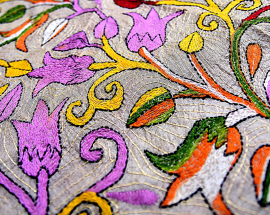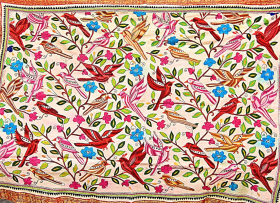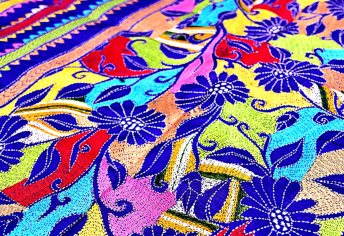Sanaih kantha
Sanaih pantha
Sanaih parvata langhanam.
– Traditional Bengali Shloka
Translation:
Slowly one stitches rags,
Slowly one traverses the path
And slowly one climbs to the top of the mountain.
It’s a great thing that we teach our children the importance of “Reduce, Reuse & Recycle”. “Less is more”, “Don’t waste”, or “use the waste to recreate” should be not the logos but with some real-world examples too. E.g. Recently many companies have joined a growing movement to ban single-use plastic straws etc. These days even at functions & weddings, people are environment conscious.
Being a saree lover, our wardrobes are full with such clothing and some of us (including me) are still dreaming/eyeing on the next one to purchase. I wonder, what would we do with the sarees that are in ok condition but not wearable anymore? In grandma’s days, she would have happily taken those sarees and created soft quilts for everyone, lasting that saree for next-next generation. A neatly cut usable cloth pieces, soft cotton material to enclose, & simple running embroidery, Voila! A quilt for a loved one.
 Kantha is about tradition. Kantha is about art. Kantha is about appeal. Kantha work is that it can be an accessory in itself. & Kantha exemplifies Reuse and Recycle concepts to its core. Any work in which Kantha embroidery is done is sometimes referred to as ‘a Kantha’. It consists generally a simple running stitch on the sarees in the form of motifs such as animals, birds, flowers, simple geometrical shapes and scenes from everyday life.
Kantha is about tradition. Kantha is about art. Kantha is about appeal. Kantha work is that it can be an accessory in itself. & Kantha exemplifies Reuse and Recycle concepts to its core. Any work in which Kantha embroidery is done is sometimes referred to as ‘a Kantha’. It consists generally a simple running stitch on the sarees in the form of motifs such as animals, birds, flowers, simple geometrical shapes and scenes from everyday life.
Kantha also refers to the indigenous quilt form and to the running stitch itself, which gives the cloth the wrinkly appearance that is characteristic of kantha. Kantha may be spelled and pronounced in various ways: kantha, kaentha, ketha, kheta.
Origin/History: Kantha (pronounced Kaatha) is an ancient form of hand-stitch embroidery. Interestingly, Kantha embroidery derives its name from the same word with two different meanings. The word also means ‘throat’ and was named so due its association with the Hindu deity, Lord Shiva. The word kontha means “rags” in Sanskrit, reflecting a tradition of using discarded clothing or vintage garments transforming them into extraordinarily renewed creations with extended life such as into bed coverings and other household items. Kantha is perhaps the oldest forms of Indian embroidery as it can be traced back to the first and second A.D. Kantha embroidery as we know it today was found in Krishnadas Kaviraj’s 500-year-old book, Chaitanya Charitamrita. Motifs found in early Kantha embroidery include many symbols that were derived from ancient art. It was not until later that Kantha embroidery was used as a medium of cultural and religious significance, which came about as a result of Hinduism’s influence and was used in ceremonies and pujas, including to celebrate weddings and births.
Though it continued to be practiced amongst rural women, recognition of the craft faded over time, until it was revived on a global scale in the 1940s by the renowned Kala Bhavana Institute of Fine Arts, which part of the Visva-Bharati University in Shanti Niketan, West Bengal.
 Several revivals of kantha embroidery and quilt making have occurred in India and Bangladesh over the past few years, which has redefined this ancient domestic tradition. It has been instrumental in empowering rural women with a supplemental source of income through stitching. Artist Shamlu Dudeja, Surayia Rahman have worked with women in rural area, teaching them the skills needed to achieve economic independence.
Several revivals of kantha embroidery and quilt making have occurred in India and Bangladesh over the past few years, which has redefined this ancient domestic tradition. It has been instrumental in empowering rural women with a supplemental source of income through stitching. Artist Shamlu Dudeja, Surayia Rahman have worked with women in rural area, teaching them the skills needed to achieve economic independence.
Kantha embroidery has definitely taken the fashion industry by storm. Sharbari Datta, an Indian fashion designer, has displayed beautiful ensembles of Kantha work, along with other Indian traditional embroideries, in several of her fashion shows. She took the traditional Kantha embroidery and gave it a unique twist. In 2013, a fashion collection featuring stunning kantha garments by Tarun Tahiliani, brought another round of global recognition to kantha textiles.
Region: In a village called Katna, Kantha is a way of life; Kantha embroidery, indigenous to West Bengal, continues to be the dominant textile art and craft of the state. Expert artisans of the art of Kantha embroidery are predominantly female as it originated as a household craft amongst rural families, with techniques passed down from mother to daughter. It is still widely practiced in the homes of millions of West Bengali rural women who reside in villages in the districts of Hooghly, Burdwan, Murshidabad, North and South 24 Parganas and Birbhum. the most prominent location for the production and purchase of Kantha embroidery, particularly the Kantha saree and Nakshi Kantha quilt, is Bolpur-ShantiNiketan, also simply known as Bolpur, located in the district of Birbhum of West Bengal.
The technique of Kantha embroidery is most popularly found in the traditional sarees of West Bengal and Odisha (Orissa), called Kantha sarees. In West Bengal, Kantha is also often used in quilting to create lightweight embroidered quilts are known as Nakshi Kantha . In Odisha (Orissa), Kantha embroidery can be found alongside the popular applique work of Puri and Pipli.
 Kantha embroidery is today often used in other garments such as dupattas and shirts, and in modern ranges of bedding and house furnishings. Kantha is used in a wide variety of ways, sometimes to adorn saris, or at times to decorate shawls or covers for mirrors. Whether its bags or dupattas, curtains or even quilts, creativity has been taken to a different level!
Kantha embroidery is today often used in other garments such as dupattas and shirts, and in modern ranges of bedding and house furnishings. Kantha is used in a wide variety of ways, sometimes to adorn saris, or at times to decorate shawls or covers for mirrors. Whether its bags or dupattas, curtains or even quilts, creativity has been taken to a different level!
Material and Variations: Kantha gives the saree a wrinkled and wavy look and transforms old clothes into extraordinarily new creations. Running stitch, darning stitch, satin and loop stitches are commonly used in Kantha work.
The kantha stitching was traditionally quite simple; beautiful old sari borders were reused and soft dhotis (men’s clothes) were stitched inside the layers together using thread drawn along the edges and create different running stitches on them which they then used as blankets for children. Kantha quilts are a vibrant patchwork of layers upon layers of patterned fabrics, bold colors and of course a rich history which is woven together with each stitch, patch and stretch of beautiful fabric.
 Initially Kantha was used on cotton or silk. But now it is used on other fabrics as well like Georgette, crepe and chiffon as well. The creation has also adopted the traditional Kantha stitch in a more contemporary form, using Bhagalpur silk and cotton cloth.
Initially Kantha was used on cotton or silk. But now it is used on other fabrics as well like Georgette, crepe and chiffon as well. The creation has also adopted the traditional Kantha stitch in a more contemporary form, using Bhagalpur silk and cotton cloth.
Based on the use of the fabric’s use, Kantha is divided into seven different types.
Lep Kantha, is used to make warm covering material, rectangular shaped padded quilts.
Sujani Kantha– pieces of rectangular cloth used in the making of bed covers or spreads for ceremonial occasions.
Baiton Kantha– used for book coverings and coverings for other objects
Oaar Kanthais rectangular shaped pillowcases that feature simple yet alluring motifs and decorative borders.
Archilata Kanthais used for covering mirrors and usually comes with colorful motifs and borders
Durjani (Thalia) Kanthais small rectangle pieces with borders, the cloth is turned into a wallet with the inward folding of three of its corners.
Rumal Kanthawhich is used to cover plates and come with a lotus motif right in the center.
Common designs: Though Kantha embroidery consists of simple running stitches, it is rather laborious and time-consuming. Born from pure imagination of rural women who adorn these Kantha sarees, Kantha embroidery portrays beautiful motifs and designs as it draws inspiration from day-to-day activities resulting in a close mesh of design in the form of beautiful flowers, birds and animal motifs or human figurines or even simple geometric patterns.
Early motifs were related to nature, the sun, the tree of life, and the cosmos. The wheel represented order in the world. Traditional motifs that reveal nature and culture are still stitched into cloth today, along with the simple running stitches seen in contemporary scarves. Ethnic designs often featured the lotus, which is a sacred flower, as well as the power of life offered by water and sun. As threads used in Kantha were traditionally taken from old sarees and dhotis and the colors found in Kantha embroidery are colors commonly seen in everyday life in India – red, yellow, green, blue and black. In contemporary Kantha, an off-white base fabric is usually used to allow the embroidered colors of the threads to catch the eye.
 Some of these motifs are known as star and pinch (tara chutki), stick (laathi) and mirror and hair buns (aina khopa).
Some of these motifs are known as star and pinch (tara chutki), stick (laathi) and mirror and hair buns (aina khopa).
The colored silken threads that run through the saree forming these lovely patterns are a treat to view. Generally, all basic Kantha patterns are enclosed within similar borders of running stitches. Borders and pallu of Sarees especially are well-adorned by exquisite Kantha work.
Where to buy from: Price ranges of Kantha sarees are based on expensive fabric and intricate patterns used in Kantha embroidery. Although I have a quilt and a silk dupatta with Kantha work, I don’t have a Kantha saree yet, a few Bengali friends have shared online resources with me, to buy a Kantha saree.
https://www.parinita.co.in/collections/kantha-silk
http://www.banglarsare.com/women-s-sarees/boutique-sarees.html
https://www.facebook.com/sixyarddreams/
Gocoop.com
A blend of everything put together in a fine seamless representation of what is truly and remarkably, a symbol of fusion fashion. Kantha is exactly that. It is an expression of an artistic spirit in a human being while keeping the sustaining principles of reduce, reuse and recycle.
Now, I have a newly found reason to dream about a Kantha saree to purchase. Don’t I?
Reference details:
Pictures credited from Internet and courtesy of friends.
http://kanthathreads.com
http://en.wikipedia.org/wiki/kantha
https://strandofsilk.com/journey-map/west-bengal/kanthaembroidery/production-technique
http://www.biswabangla.in/sarees/2016/5/17/bostani
Know Your Craft : Kantha – The Ancient Indian Hand Embroidery of Precision & Beauty







